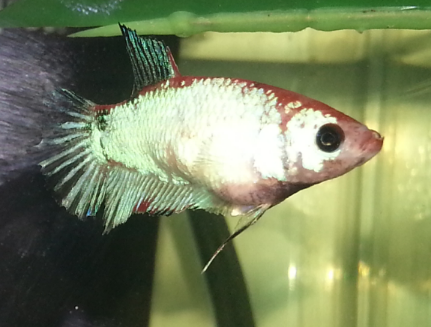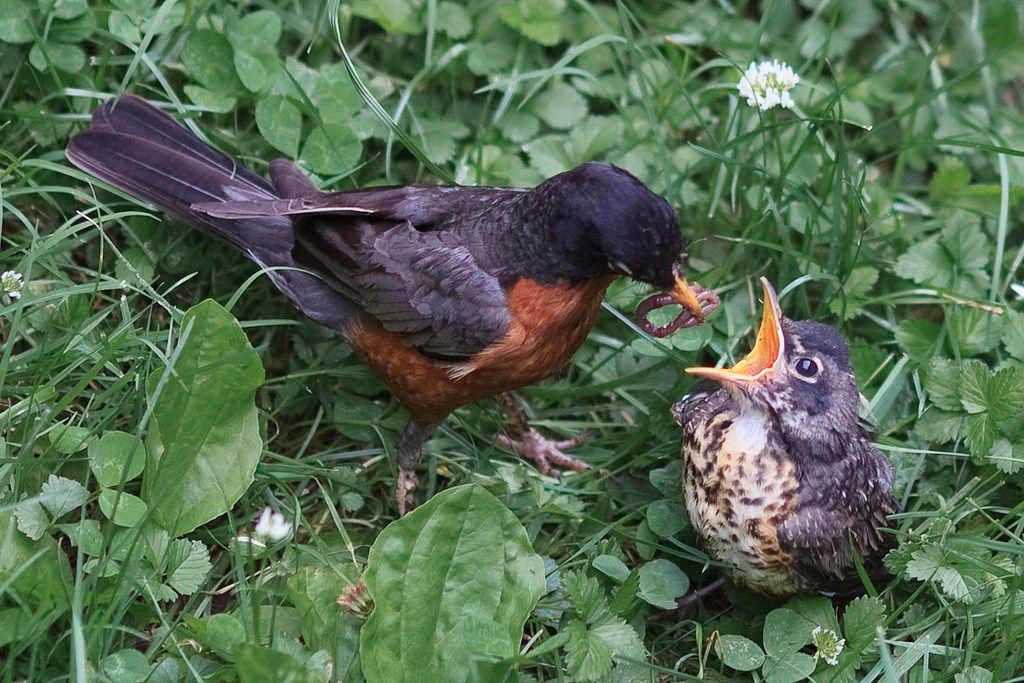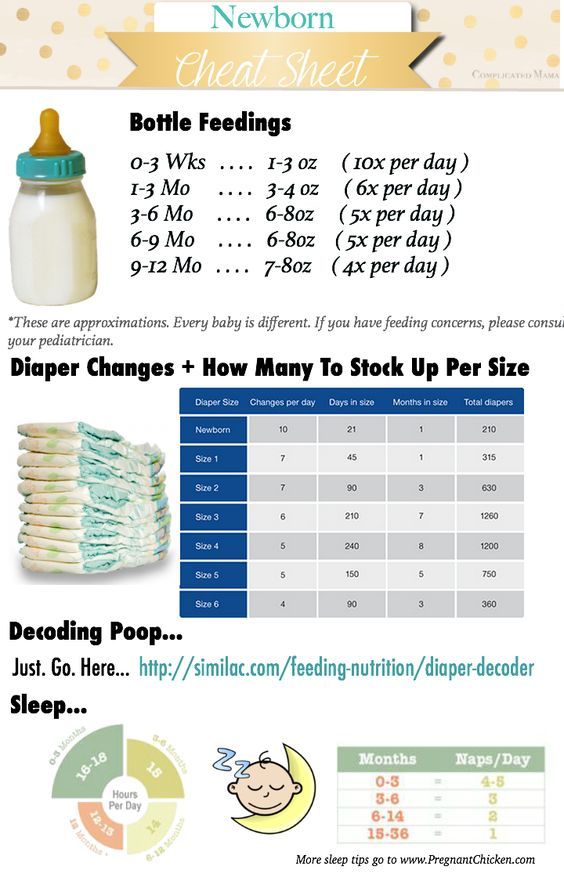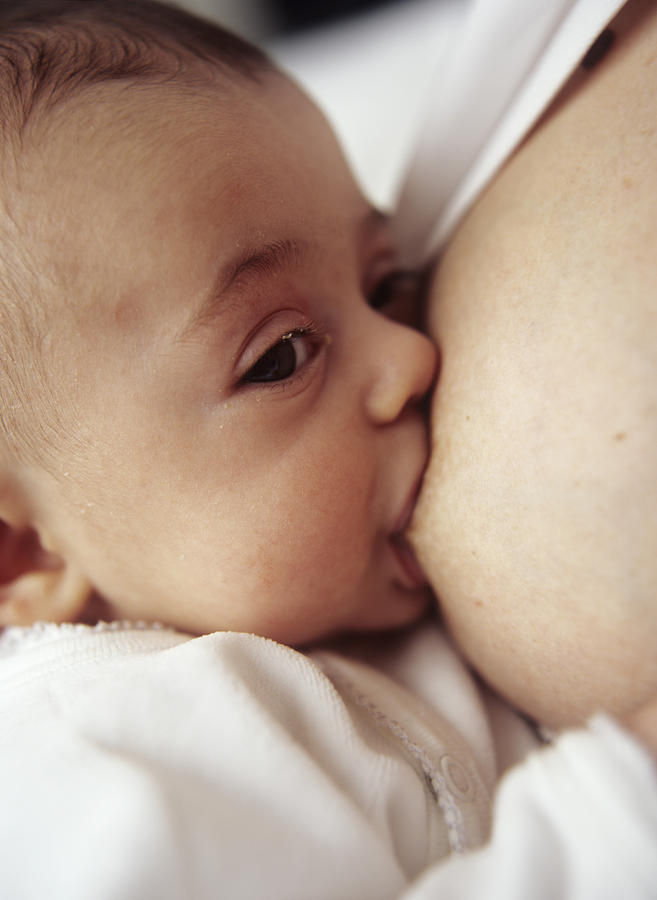Baby will only feed lying down
Breastfeeding lying down is nursing goals
Here's what you need to know about breastfeeding your baby while lying down in the side-lying position and step-by-step tips on how to do it.
Breastfeeding lying down is often touted as the promised land of nursing positions, but it’s not the easiest one for some new moms. Still, it’s worth trying, as it can help make breastfeeding more comfortable for you and your baby.
Wondering how to get it right? A couple of lactation consultants who have helped many parents master this position share their best tips.
What is the side-lying position used for?
Ask anyone who has mastered breastfeeding lying down and they’ll say the biggest benefit is that it helps sleep-deprived new moms get more rest by lying down for some of their baby’s feedings. “It’s really relaxing,” says Dallas Parsons, an international board-certified lactation consultant based in South Surrey, BC. It’s also less disruptive to your sleep if you’re able to pull your baby into bed rather than sit up to nurse them.
But aside from helping parents feel more rested (no small feat!), breastfeeding lying down can be useful if your perineum was damaged during your baby’s birth, as sitting on your sitz bones to nurse can be painful, says Taya Griffin, an international board-certified lactation consultant based in Toronto. There are other postnatal circumstances that this position can be handy for as well. Griffin explains that one of her clients was unable to sit up without vomiting because of an epidural headache, while another one had postpartum depression and stayed in bed. In both cases, the side-lying position was a lifesaver.
In addition to being a boon for the parent, side-lying can help some babies nurse better. “If the baby has had a lot of birth trauma, has torticollis or other neck issues or has undergone a forceps or vacuum delivery, they often benefit when their mother spends the time to learn how to breastfeed lying down because there’s no pressure placed anywhere on the baby’s skull or neck,” explains Griffin. “Once the baby has latched, they might actually be happier and more relaxed and open their mouth wider because they’re just lying on their side.”
“Once the baby has latched, they might actually be happier and more relaxed and open their mouth wider because they’re just lying on their side.”
If a baby is frustrated with the flow of milk, breastfeeding lying down may help in this situation, too. “I’ll often try the side-lying position if the baby is fussy because sometimes both mom and baby are more relaxed and the milk flows better,” says Griffin. If a lactation consultant has determined that the opposite is true, where you have a ton of milk, the side-lying position can come to the rescue also – you can lie on a towel in bed and any milk that dribbles out of your baby’s mouth lands on the towel, not your stomach, as it might if you were sitting up, says Griffin.
How to breastfeed lying down
Here’s how Griffin and Parsons suggest that you breastfeed lying down. You may need to make some adjustments to find what works best for you and your baby.
1. Make sure that there are no blankets or duvets near your baby on the bed and that the bed sheet is tight on a firm mattress.
2. Place your baby on the bed on their back.
3. Lie down on your side beside your baby.
4. Place a pillow behind your back to lean against slightly. “This will lift your nipple and breast off the bed a little so that your baby can get a lot of the areola in their mouth,” explains Griffin. “This, of course, will depend on the size of breast. If the breast is smaller, you might not have to lean in. If the breast is larger, you might need to lean back a little farther.”
5. Check your leg position. Some babies are quite strong and will push their legs against your upper legs, which can affect their latches. To avoid this, keep your legs straight and aligned with your hips rather than curl your body around the baby, suggests Griffin.
6. Place a pillow between your knees to neutralize the spine and make it more comfortable, says Griffin, and place a pillow under your head.
Is ‘breastsleeping’ best?7. Once you’re all set up, place your baby on their side so that you and your baby are facing tummy to tummy. Your baby’s nose should be lined up with the nipple of your bottom breast to encourage them to look up and open their mouth wide.
8. Bring your baby onto the breast deeply (just as you would with a regular latch), with your top hand behind their shoulder blades, and pull them in when their mouth is open. “Some moms need to actually lean on their elbows and support their breasts while their babies latch on,” says Griffin.
9. Roll up a receiving blanket and place it alongside your baby’s spine. This will help keep them propped up and allow them to latch onto the breast deeply without your hand on their back, says Griffin. This also frees up your top hand to do breast compressions, adds Parsons, which can speed up a feeding when you increase the flow by gently squeezing your breast.
10. Depending on your routine, you may need to switch sides. Some moms are able to lean over toward their baby and offer the top breast, which means that you don’t have to flip your baby over. But if that doesn’t work for you, lie on your back, place your baby on your chest, reposition yourself and nurse them on the opposite side. Parsons says that it’s important to not continuously neglect the other side because it could end up blocked or uncomfortable.
Some moms are able to lean over toward their baby and offer the top breast, which means that you don’t have to flip your baby over. But if that doesn’t work for you, lie on your back, place your baby on your chest, reposition yourself and nurse them on the opposite side. Parsons says that it’s important to not continuously neglect the other side because it could end up blocked or uncomfortable.
Is it safe to fall asleep while breastfeeding lying down?
Both the Public Health Agency of Canada and the Canadian Paediatric Society (CPS) say that bed sharing is not recommended. The CPS lists several risk factors for babies sleeping in adult beds, including a higher risk of sudden infant death syndrome (SIDS), falls, suffocation and overheating. That being said, many people still end up sleeping with their babies, whether intentionally or not.
If you’re nursing in the side-lying position, it’s a good idea to create the safest sleep environment possible in case you do end up falling asleep, suggests Parsons. “It’s better to set up your bed safely for those instances,” she explains. La Leche League has developed a set of guidelines for safer bed sharing called The Safe Sleep Seven. They say that those sharing the bed should be non-smokers and sober.
“It’s better to set up your bed safely for those instances,” she explains. La Leche League has developed a set of guidelines for safer bed sharing called The Safe Sleep Seven. They say that those sharing the bed should be non-smokers and sober.
While breastfeeding has been found to reduce the risk of SIDS, research has found that when babies are primarily breastfed, the nursing mother tends to position herself in a way that protects the baby from accidental suffocation (from either the parent or a blanket). As well, the baby tends to adopt a position near the breast, safely away from pillows and other possible dangers. The baby should also be healthy and full-term, sleep on their back and be lightly dressed (not swaddled). The sleep surface must be safe, too, which means a fairly firm mattress free of extra pillows, toys and heavy covers; no dangling strings or cords nearby; any cracks (say, between a headboard or wall and the mattress) packed with rolled-up blankets or towels; and, if you cover the baby, bedding that is lightweight and away from your baby’s head.
Can you feed a newborn lying down?
Yes, you can! However, both Griffin and Parsons say that it takes practice, so parents who aren’t confident in nursing may be intimidated by this position. Griffin adds that it’s a good idea to know a good latch beforehand because latching while lying down is slightly trickier, and she has seen clients who have damaged their nipples from doing side-lying nursing without getting that sorted out first. But that doesn’t mean you shouldn’t try—you just might need some help if it doesn’t work out the first time. “You need to make sure that the baby’s lined up properly and latched on deeply,” says Parsons. “If it hurts, try adjusting. If you can’t get it right then, you might want to ditch it for now and come back to it.”
Griffin, who wasn’t able to master this position until her oldest child was two months old, used to latch her youngest daughter in a cross-cradle position while sitting on the edge of the bed and then slowly inch her way down. “I’d have a pillow ready and hold onto her tightly,” she explains. “Then, when I was almost lying down, I’d let go of her bum and fall onto the bed.” She would then place a rolled-up receiving blanket along her baby’s spine to keep her in position. “Seven out of 10 times, I would actually get a really good latch,” she says.
“I’d have a pillow ready and hold onto her tightly,” she explains. “Then, when I was almost lying down, I’d let go of her bum and fall onto the bed.” She would then place a rolled-up receiving blanket along her baby’s spine to keep her in position. “Seven out of 10 times, I would actually get a really good latch,” she says.
How to get help with the side-lying position
There are plenty of resources, both online and offline, to give you a hand with breastfeeding lying down. Parsons, who only started using it regularly with her third baby, says it’s worth seeking help and trying to figure it out. “It’s such a wonderful thing to be able to lie down to feed your baby,” she explains. “If you’re struggling, look for that YouTube video that works or go to a La Leche League meeting and get someone to show you how to do it. It really is one of the best things about breastfeeding,” she says, laughing. If you can afford it, investing in a lactation consultant who will come to your house to teach you is a great idea, too. “Having someone come into your home, with your pillows and your bed, can be a big help,” says Griffin.
“Having someone come into your home, with your pillows and your bed, can be a big help,” says Griffin.
Read more:
How breastfeeding your second kid can be completely different than your first
5 common breastfeeding mistakes and how to avoid them
What is a dream feed—and how do I do it?
Watch Baby Grow!
Subscribe to Today’s Parent’s baby newsletter and find out what to expect for every stage and milestone, from birth to two years.- Email*
- Baby's due/birth date*
Month223456789101112
Day12345678910111213141516171819202122232425262728293031
Year2024202320222021
- CAPTCHA
- Consent*
Yes, I would like to receive Today's Parent's Baby newsletter. I understand I can unsubscribe at any time.**
FILED UNDER: Baby 0-3 months Baby tips Breastfeeding epidural Maternal health New mom Newborn care nursing perineal tearing Postpartum depression SIDS
Elevated side lying bottle feeding — Feed Eat Speak
Infant feedingFeeding difficultiesBottle Feeding
Written By Stacey Zimmels
Elevated side lying is a bottle-feeding position that’s being used more and more for preterm babies and infants who have feeding difficulties.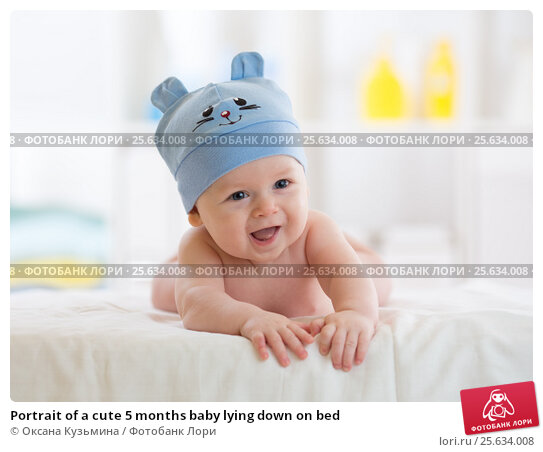 In this blog post I’ll tell you why I like it for all new born babies. I’ve put together a visual step by step guide for you so go ahead and give it a try…
In this blog post I’ll tell you why I like it for all new born babies. I’ve put together a visual step by step guide for you so go ahead and give it a try…
This position is a natural and physiologically normal feeding position just like how a baby feeds at the breast. It means the baby doesn’t have to do any work at all to support its body while it feeds which makes for an easier and more relaxed feed for both the baby and you.
Baby is positioned on a cushion which means that you don’t have to take the baby’s weight on your arms which is more comfortable especially as your baby grows.
You have a hand free if you need it to read to a toddler or have a drink while you’re feeding your baby.
If the flow of milk is too fast - which it often can be at the start while your baby is mastering its suck swallow and breathe co-ordination – this position allows the milk to safely dribble out of your babies mouth instead of coughing or choking.
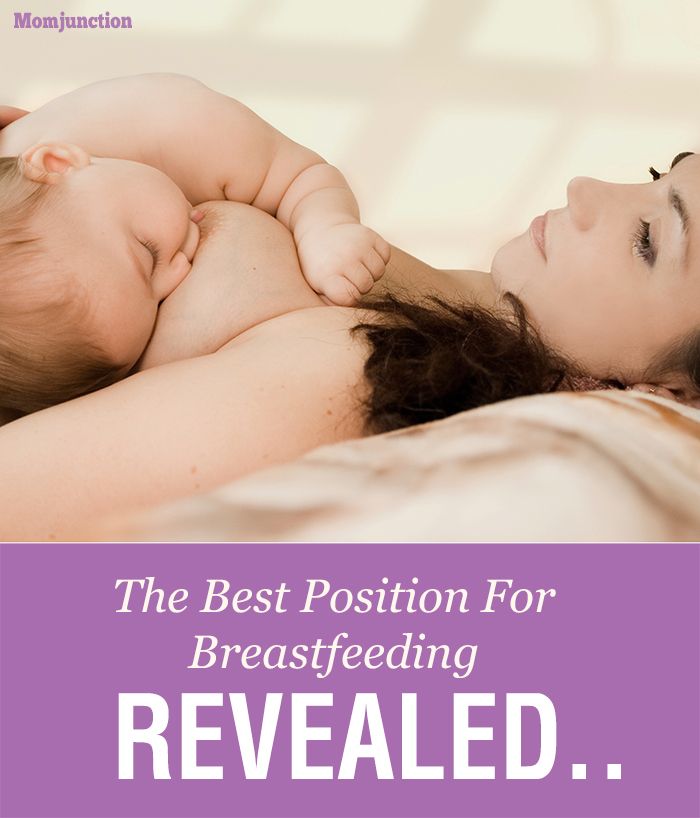
You are able to clearly see your baby’s face and watch for signs that she may need a pause or a break for winding.
This is a great position for babies who have reflux or who are prone to vomiting. If you place the baby on its left side to feed it increases the space from the bottom of its stomach to the oesophagus making it less likely for them to vomit or reflux.
This feeding position is more typically recommended for formula fed babies, rather than the paced bottle feeding technique. which tends to be recommended for breastfed babies who also take the bottle. However I would suggest that with the horizontal presentation of the teat and the pacing as per the paced bottle feeding technique that this feeding position can be used in both groups of infants.
Step by step guide to elevated side lying bottle feeding
Sit comfortably on the sofa and place your feet on a footstool. This plastic childrens' one from ikea does the trick. Your legs should be sloping from the knees to your hips
Your legs should be sloping from the knees to your hips
Place your baby on its side with her bottom against your tummy. Her legs should be out in front of her. If you're right handed then baby on her left side and visa versa
Your baby will bring her hands together on her chest in a flexed position. Offer the bottle, wait for her to open her mouth and place inside. Note how relaxed and content your baby looks
Chelsey and Jaxon's story
I had my baby boy Jaxson in April 2020 and he was born with a tongue tie which meant he wasn't able to latch comfortably when breast feeding. I could tell this was the issue from day one as his older brother was also born with one and we had the same feeding issue.
Due to the covid19 circumstances I wasn't able to get the tie cut with Jaxson as quickly as I did my 2 year old. So for 4 months I expressed every feed and bottle fed him. His tie was cut privately at 10 weeks old and I chose to continue to bottle feed.
So for 4 months I expressed every feed and bottle fed him. His tie was cut privately at 10 weeks old and I chose to continue to bottle feed.
Jaxson was a very windy baby and in the early days he really struggled to feed comfortably, he had lots of trapped wind which would not come up easily. He would cry in pain after most feeds which was very upsetting for both of us. I tried everything I could buy from the pharmacy as us mums do and also turned to social media where I found @feedeatspeak. I was scrolling though Stacey's feed and saw posts of the elevated side lying position. I immediately tried this with Jaxson who at the time was around 4 weeks old and he was a changed baby! He was able to bring up wind much easier and seemed so much more content. He actually started enjoying his feeds and upped the amount he was having quite soon after. I was one very happy Mama with a much happier baby!
So thanks to Stacey and her wonderful page, Jaxson now at 6 months old is still feeding is this position and he is one happy thriving baby!
I am so grateful for Stacey sharing this advice and information especially during lockdown as us new mums didn't really have anywhere to turn. So thank you so much for helping my baby!
So thank you so much for helping my baby!
I tell all my mummy friends about this feeding position and Stacey's page hoping to help their babies who struggle with bottle feeding. It really made a huge difference with Jaxson!
bottlebottle feedingfeedingbaby feedingsidelyingelevated side lying
Stacey Zimmels
Eats only lying down, what to do?: malyshi — LiveJournal
?- Children
- Food more convenient. I think this is not uncommon and there is nothing wrong with it.
But it has been experimentally calculated that complementary foods are also convenient for him only when lying down. I have been feeding him this way for a month now, he eats decently, he opens his mouth, almost never coughs or chokes, there are "favorite dishes", i.e. flight is normal. I didn’t really worry about it, he likes lying down, let him eat. But a relative, a pediatric resuscitator, came to visit, and was horrified. He said that he had never seen such food in his life, he began to talk about how children choke and suffocate and all that.
I have been feeding him this way for a month now, he eats decently, he opens his mouth, almost never coughs or chokes, there are "favorite dishes", i.e. flight is normal. I didn’t really worry about it, he likes lying down, let him eat. But a relative, a pediatric resuscitator, came to visit, and was horrified. He said that he had never seen such food in his life, he began to talk about how children choke and suffocate and all that. I started trying to feed while sitting, half-sitting - it's terrible. It is evident that he is hard and does not like it. It is difficult to swallow, it is difficult to grab a spoon in your mouth. He cries uncontrollably, turns away, closes his mouth tightly, pushes the spoon away with his hands, turns the bowl of food over, it's just hell (rarely seen him have such a reaction), and eats almost nothing in this way. I suffered for this feeding too, a lot of nerves and seven sweats :(
Then I put it down and began to feed as usual, but he was on edge and continued to cry, in general he didn’t eat :(Damn, what to do about it? Everywhere they write that it’s right to feed while sitting, I’m now driven about what can choke, I’m afraid that I’ll get used to this way of eating tightly, and retraining is very painful, and most likely this will mean that the child will almost never receive complementary foods: (
What would you say about feeding lying down? Would you be horrified? Would you advise? Is there any relationship with lying down guards? For the first few months we struggled with little milk, we didn’t get out of bed with a boob in our mouth, could it affect? Maybe when it gets better sit, will something change? (Now he sits down on his own, but occasionally, and sits leaning on his hands and tilting his head down; he simply cannot sit without leaning with a straight back). Maybe there is someone with a similar experience, share?
Maybe there is someone with a similar experience, share? Tags: 6-9 months
Subscribe
-
Favorite books up to 3 years old (with text and not poetry) ? And not Wimmelbuhi, but text, at least a little, but ...
-
Daughter is afraid of other children
Good afternoon! Again, a collective mind is required 🙂 My brave and sociable girl of 4.5 years old has become very afraid of unfamiliar children. If on…
Photo
Hint Previous
← Ctrl ← Alt- 1
- 2
Next
Ctrl → Alt →-
Favorite books up to 3 years old (with text and not poetry)
There was a question, I can't stand a book fast) What books do you have for kids up to three years old? And not Wimmelbuhi, but text, at least a little, but .
 ..
.. -
Daughter is afraid of other children
Good afternoon! Again, a collective mind is required 🙂 My brave and sociable girl of 4.5 years old has become very afraid of unfamiliar children. If on…
Different breastfeeding positions
Try different breastfeeding positions to find the one that works best for you and your baby. You can see the options in our selection of photos
Share this information
There is no right or wrong way to hold the baby while
feeding, and mom and baby are sure to find their favorite position.
It is important that both you and your child feel comfortable. 1.2 It's good to learn a few different breastfeeding positions and techniques because life's circumstances often require us to be flexible, especially as your baby gets older and you start to leave the house more often.Whatever position you choose to breastfeed your baby, remember a few simple rules.

- Prepare everything you need before feeding, including drinks, food, mobile phone, TV remote control, book or magazine. And do not forget to go to the toilet - the feeding process can take a long time!
- Make sure your baby is comfortable. Whichever position you choose, it's important to keep your baby strong, level, and provide good support for their head, neck, and spine.
- You should also be comfortable. Don't stress. If necessary, use pillows of different sizes or rolls of towels to support your back or arms.
- Make sure your baby is latching on correctly. Proper grip is the key to comfort when breastfeeding.
- If your baby does not latch on well or you experience pain while feeding, contact a lactation consultant for help. The specialist will also be able to show you how to hold your baby more comfortably.
1. Relaxed feeding or reclining position
The relaxed feeding position, also known as biological feeding, 1 is often the first position for most mothers.
 If, immediately after birth, the baby is placed on the mother’s chest or stomach, normally, he instinctively reaches for the breast and tries to grab the nipple. This phenomenon is known as the breast seeking reflex. Skin-to-skin contact stimulates the infant's feeding instinct, and gravity helps him to latch onto the breast and maintain balance.
If, immediately after birth, the baby is placed on the mother’s chest or stomach, normally, he instinctively reaches for the breast and tries to grab the nipple. This phenomenon is known as the breast seeking reflex. Skin-to-skin contact stimulates the infant's feeding instinct, and gravity helps him to latch onto the breast and maintain balance. But not only newborns can be fed in the reclining position - this position is great for babies of any age. It can be especially helpful if your baby does not latch well in other positions or does not like to be touched during feeding, and also if you have too much milk flow or too large breasts. Isabelle, a mother from the UK, shares her experience: “I had large breasts, and the baby was born small - 2.7 kg, so it was not easy to find a comfortable position at first. After a few weeks, it became clear that there was no “correct” posture for me. As a result, I most often fed lying down, putting the baby on my chest. ”
It is more convenient to feed not lying flat on your back, but half-sitting, leaning on pillows.
 So you will have a back support and you will be able to watch the baby during feeding.
So you will have a back support and you will be able to watch the baby during feeding. 2. Cradle position
This is the classic position that comes to mind first when
the subject of breastfeeding is mentioned. Mom sits
straight, and the baby lies on her side on her arm, pressing her stomach against her stomach. 3 Although this is a very popular position, it is not always easy to master with newborns because it gives the baby less support. Try putting a pillow under your back, and put a special breastfeeding pillow on your knees and lean on it with your hands. So you can more reliably support the child, without overstraining your back and shoulders. Just make sure that the baby does not lie too high on the pillow for feeding. The breast should remain at a natural level so that the baby can grab it without effort, otherwise sore nipples cannot be avoided.“I breastfed in the cradle position because it suited me perfectly! It was comfortable and I loved just sitting and looking at my little one,” recalls Rachel, a mother of two from Italy.

3. Cross Cradle
This breastfeeding position looks almost exactly like the cradle, but the baby is on the other arm. 3 This gives baby support around the neck and shoulders so he can tilt his head to latch on. This position is great for breastfeeding newborns and small babies, as well as for babies who do not latch well. Since the baby lies completely on the other hand, it becomes easier to control his position and you can adjust the chest with your free hand.
Julie, a mother of two from the UK, finds this position very practical: “I usually breastfeed my youngest in the cross cradle position. So I have a free second hand, and I can take care of an older baby at the same time. ”
Do not hold the baby's head at first, otherwise you may inadvertently press his chin against his chest. Because of this, the child will not be able to take the breast deeply, because the nipple will rest against the base of the tongue, and not against the palate, which will lead to inflammation of the nipples.
 As the child grows, this position becomes more comfortable, and he can rest his head on your palm (as shown in the photo above).
As the child grows, this position becomes more comfortable, and he can rest his head on your palm (as shown in the photo above). 4. Underarm breastfeeding
In this position, also known as the "ball grip", the mother sits and the baby lies along her arm at the side, legs towards the back of the chair (or any other seat). 3 Another comfortable position for newborn breastfeeding, you can give your baby good support, have full control of his position, and have a good view of his face. And the baby feels safe in close contact with the mother's body. This position is especially good for those who have had a caesarean section or a premature birth, as well as mothers of twins and women with large breasts.
“When I breastfed my first daughter, I had very large K-sized breasts—twice the size of her head,” recalls Amy, an Australian mother of two. - I put rolls of towels under each breast, because they were very heavy, and fed my daughter in a pose from under the arm, but only sitting straighter so as not to crush her.
 This position was also convenient because I had a caesarean section and could not put the baby on my stomach.”
This position was also convenient because I had a caesarean section and could not put the baby on my stomach.” 5. Side-lying position
The side-lying position is ideal for relaxed
feedings at night in bed or on the couch. If you had a
caesarean section or ruptures during childbirth, this position may be more comfortable than sitting down. 3 In this position, mother and baby lie side by side, tummy to tummy.“It was difficult for me to sit during endless night feedings, firstly because of the caesarean section, and secondly because of lack of sleep,” recalls Francesca, a mother from the UK. “And then I discovered that you can feed your baby lying on your side and rest at the same time.”
“Because of the short tongue frenulum, Maisie could only properly latch on to her breasts while lying on her side. The lactation consultant showed me how it's done. In this position, the flow of milk was optimal for my daughter, and it was easier for her to keep the nipple in her mouth.
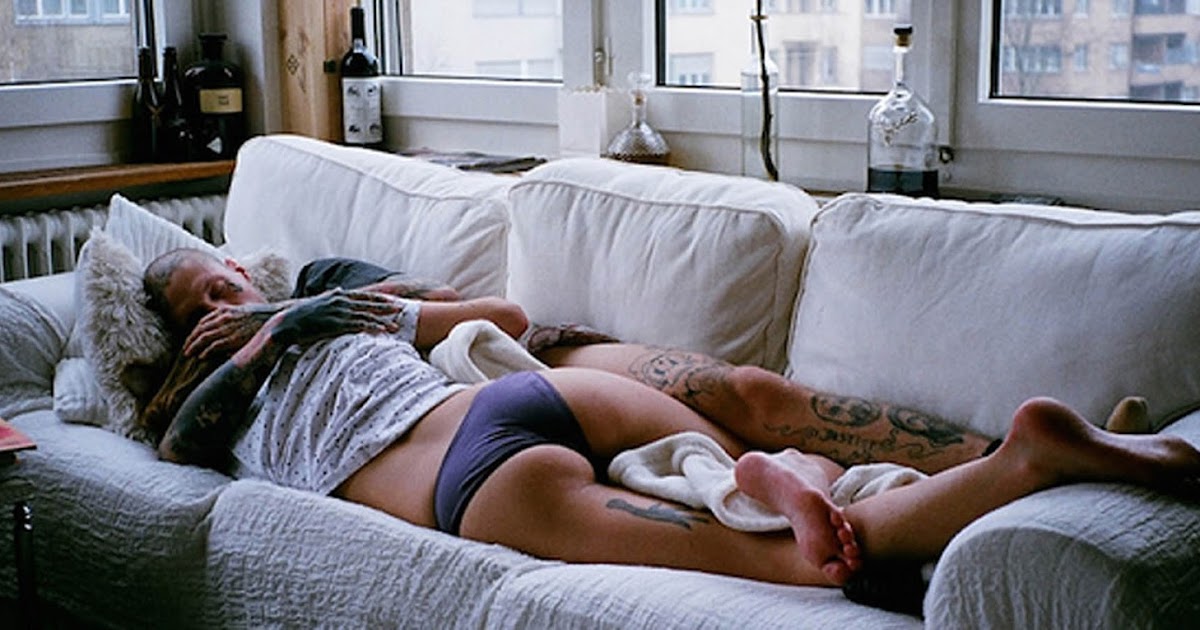 As she got older, she became much better at grabbing her breasts in normal positions,” says Sarah, mother of two from Australia.
As she got older, she became much better at grabbing her breasts in normal positions,” says Sarah, mother of two from Australia. 6. Relaxed breastfeeding after caesarean section
If you can't find a comfortable position for breastfeeding after caesarean section, 3 try to hold the baby on the shoulder while reclining — this does not put pressure on the postoperative suture and allows you to breastfeed the baby comfortably. You can also try side feeding.
7. Upright breastfeeding or “koala pose”
When breastfeeding in an upright position or “koala pose”, the baby sits with a straight back and a raised head on the mother's hip. 4 This position can be tried even with a newborn if it is well supported, but it is especially convenient for feeding an older child who can already sit up by himself. The upright sitting position, or “koala pose,” is great for toddlers who suffer from reflux or ear infections and feel better sitting. In addition, this pose may be suitable for children with a shortened frenulum of the tongue or reduced muscle tone.
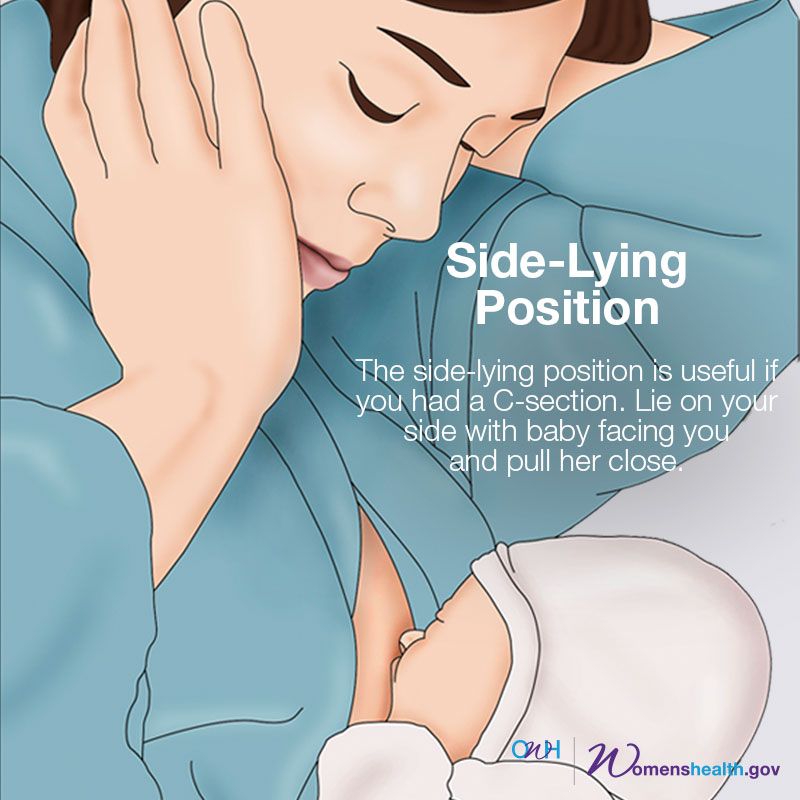
“When my daughter got a little older, I would often feed her in an upright position — it was more comfortable for both of us, and I could still hold her close to me,” recalls Peggy, a mother from Switzerland. “Besides, it was possible to discreetly breastfeed her in public places.”
8. Overhanging position
In this position, the baby lies on his back, and the mother bends over him
on all fours so that the nipple falls directly into his mouth. 4 Some moms say this breastfeeding position is good to use from time to time for mastitis, when touching the breasts is especially unpleasant. Some say that this breastfeeding position helps with blockage of the milk ducts, although there is no scientific evidence for this yet. You can also feed in the “overhanging” position while sitting, kneeling over the baby on a bed or sofa, as well as reclining on your stomach with support on your elbows. Pillows of various sizes that you can lean on will help you avoid back and shoulder strain.
“I have breastfed several times in the overhang position for clogged milk ducts when no other means of resolving the blockage worked. And this pose seems to have helped. I think it’s because of gravity, and also because the breasts were at a completely different angle than with normal feeding, and my daughter sucked her differently, ”says Ellie, a mother of two from the UK.
Feeding in the "overhanging" position is unlikely to be practiced regularly, but in some cases this position may be useful.
“I used to breastfeed in the overhang position when my baby was having trouble latch-on,” says Lorna, mother of two in the UK. - This, of course, is not the most convenient way, but then I was ready for anything, if only he could capture the chest. We succeeded and have been breastfeeding for eight months now!”
9. Feeding a baby in a sling or “on the fly”
Breastfeeding in a sling takes some practice, but it can be used to go out of the house, look after older children or even do a little household chores.

The sling is also useful if the baby does not like to lie down or is often attached to the breast. Lindsey, a mother of two in the US, notes: “I used the carrier frequently for both of my children. When we were out, I tied the sarong around my neck and covered the carrier with it. Under such a cape, the baby can eat as much as he wants until he falls asleep.
This breastfeeding position is best when the baby is already good at breastfeeding and can hold its head by itself. Any slings are suitable for breastfeeding, including elastic and rings, as well as carrying bags. Whatever option you choose, the main thing is that you can always see the face of the child, and his chin does not rest against his chest.
10. Double hand-held breastfeeding
Double hand-held breastfeeding (or “double-ball grab”) is great for mothers of twins—you can breastfeed both at the same time and still have relatively free hands. 4 When feeding in this position, it is advisable to use a special pillow for breastfeeding twins, especially at first.
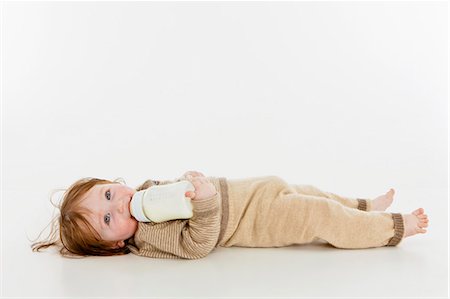 It will provide extra support and help keep both babies in the correct position, as well as reduce the burden on the abdomen if you had a caesarean section. In addition, the hands are freer, and if necessary, you can deal with one child without interfering with the second.
It will provide extra support and help keep both babies in the correct position, as well as reduce the burden on the abdomen if you had a caesarean section. In addition, the hands are freer, and if necessary, you can deal with one child without interfering with the second. “My twins were born very tiny and had to be fed every two hours at any time of the day or night. Very soon it became clear: if I want to do anything besides feeding, I need to feed them both at the same time, - says Emma, mother of two children from the UK. “I breastfed them two by hand using a breastfeeding pillow.”
Other good positions for breastfeeding twins are two criss-cross cradles, one baby in the cradle and the other close at hand, reclining or sitting upright feeding (one baby on one side, the other on the other).
11. Feeding in the “hand-supported breast” or “dancer's hand” position
muscle tone (which is typical for premature babies, children suffering from various diseases or Down syndrome), try supporting his head and your chest at the same time.
 4 Grab your chest with your palm underneath so that your thumb is on one side and all the others are on the other. Move your hand slightly forward so that your thumb and forefinger form a "U" just in front of your chest. With the other three fingers, continue to support the chest. With your thumb and forefinger, hold the baby's head while feeding so that his chin rests on the part of the palm between them, your thumb gently holds the baby on one cheek, and your index finger on the other. So the baby gets excellent support, and you can control his position and see if he is holding his breast.
4 Grab your chest with your palm underneath so that your thumb is on one side and all the others are on the other. Move your hand slightly forward so that your thumb and forefinger form a "U" just in front of your chest. With the other three fingers, continue to support the chest. With your thumb and forefinger, hold the baby's head while feeding so that his chin rests on the part of the palm between them, your thumb gently holds the baby on one cheek, and your index finger on the other. So the baby gets excellent support, and you can control his position and see if he is holding his breast. Literature
1 Colson SD et al. Optimal positions for the release of primitive neonatal reflexes stimulating breastfeeding. Early Hum Dev . 2008;84(7):441-449. - Colson S.D. et al., "Optimal Positions for Provoking Primitive Innate Reflexes to Induce Breastfeeding." Early Hume Dev. 2008;84(7):441-449.
2 UNICEF UK BFHI [ Internet ].
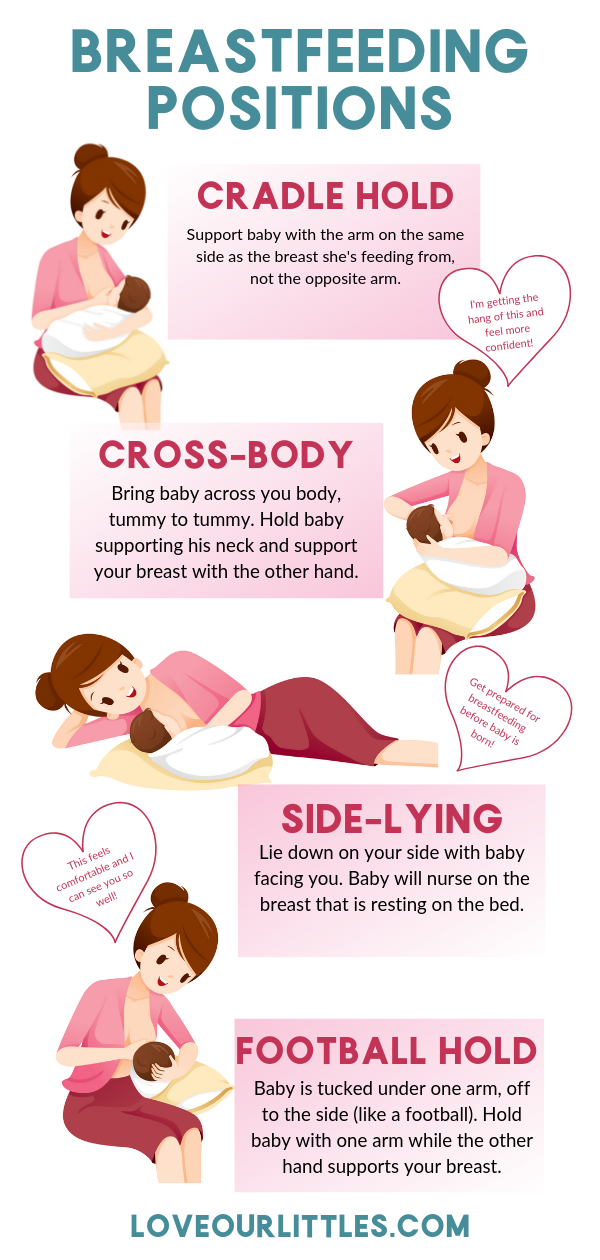
-



